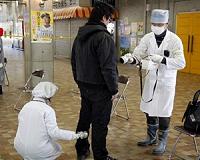 |
Raleigh NC (SPX) Apr 14, 2011 A combination of forest byproducts and crustacean shells may be the key to removing radioactive materials from drinking water, researchers from North Carolina State University have found. "As we're currently seeing in Japan, one of the major health risks posed by nuclear accidents is radioactive iodide that dissolves into drinking water. Because it is chemically identical to non-radioactive iodide, the human body cannot distinguish it - which is what allows it to accumulate in the thyroid and eventually lead to cancer," says Dr. Joel Pawlak, associate professor of forest biomaterials. "The material that we've developed binds iodide in water and traps it, which can then be properly disposed of without risk to humans or the environment." The new material - a combination of hemicellulose, a byproduct of forest materials, and chitosan, crustacean shells that have been crushed into a powder - not only absorbs water, but can actually extract contaminates, such as radioactive iodide, from the water itself. This material, which forms a solid foam, has applications beyond radioactive materials. Pawlak and fellow researchers found that it has the ability to remove heavy metals - such as arsenic - from water or salt from sea water to make clean drinking water. "In disaster situations with limited-to-no power source, desalinating drinking water is difficult, if not impossible. This foam could be brought along in such situations to clean the water without the need for electricity," Pawlak says. "This material could completely change the way we safeguard the world's drinking water supply." The foam, which is coated on wood fibers, is used like a sponge that is immersed in water. For smaller-scale applications, the foam could be used in something like a tea bag. Or on a larger scale, water could be poured through it like a filter. Pawlak worked with NC State professor Dr. Richard Venditti on the research, which was funded by the Consortium for Plant Biotechnology Research, the N.C. Forestry Foundation and the U.S. Department of Energy. Additional research into how the material can be used on a larger scale is currently being conducted.
Share This Article With Planet Earth
Related Links North Carolina State University Space Technology News - Applications and Research
 WHO eyes 20 year nuclear health watch in Japan
WHO eyes 20 year nuclear health watch in JapanGeneva (AFP) April 13, 2011 The World Health Organisation is seeking studies for up to 20 years to keep watch over public health in Japan following the Fukushima nuclear emergency, a senior official said on Wednesday. WHO environmental health chief Maria Neira played down a current risk to public health outside the 30-kilometre exclusion zone around the Fukushima Daiichi plant, based on tests and monitoring by Japanese ... read more |
|
| The content herein, unless otherwise known to be public domain, are Copyright 1995-2010 - SpaceDaily. AFP and UPI Wire Stories are copyright Agence France-Presse and United Press International. ESA Portal Reports are copyright European Space Agency. All NASA sourced material is public domain. Additional copyrights may apply in whole or part to other bona fide parties. Advertising does not imply endorsement,agreement or approval of any opinions, statements or information provided by SpaceDaily on any Web page published or hosted by SpaceDaily. Privacy Statement |